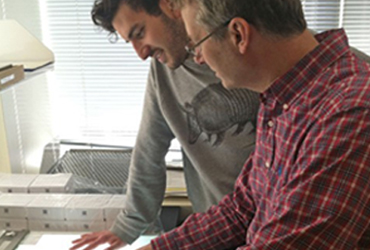Matthew Vander Heiden: Back to the Basics
When Matthew Vander Heiden was working on his MD/PhD, trying to understand how apoptotic cell death is regulated by bcl-2 proteins located at the mitochondrial outer membrane, it occurred to him he would have to go back to basics.

“If I’m going to try to understand how apoptosis is regulated at the mitochondria, I better relearn how mitochondria work,” he recalls thinking while working in the University of Chicago lab of Craig Thompson, MD (now head of Memorial Sloan Kettering Cancer Center).
And so it was that he pulled out the textbooks he had studied years before, when, like all students in the life sciences, he was introduced to the engines that power the biochemical processes of the cell.
“You sort of memorize these things and it’s taught as if this is all known, and you want to get to the interesting parts of what’s unknown in biology,” he says. “But there’s actually a lot that’s not known about metabolism, and a lot of open questions.”
While focusing on how mitochondrial events of apoptosis are regulated by Bcl-2 proteins, Vander Heiden and his colleagues discovered that some of these proteins also impacted metabolism at the mitochondria.
“That taught me that maybe we didn’t understand metabolism as well as we thought we did,” he says, leading to his career-long interest in cellular metabolism. At the same time, in his medical training, he was becoming interested in oncology, and was intrigued by the connections between metabolism and cancer.
“Understanding how mitochondria work, how nutrients are metabolized, how different cancers rely on different nutrients and why they do — I think this holds a key to understanding a lot about cancer,” he says. “Metabolism is fundamental to how cells proliferate and to what becomes limiting for proliferation.”
Vander Heiden continued his research as a postdoc under Lewis C. Cantley, PhD, who was then at Harvard Medical School and is now at Weill Cornell Medical College. In a 2009 paper in Science co-authored with Thompson and Cantley, he proposed that the metabolism of cancer cells facilitates the uptake of nutrients needed to produce new cells, a new way of looking at the “Warburg effect” in glycolysis.
In 2010, Vander Heiden joined the Cancer Center at the Massachusetts Institute of Technology, now called the Koch Institute for Integrative Cancer Research. After a few years, his lab was competing with well-established researchers for mainstream funding. He was glad to get the 2014 AACR Gertrude Elion Research Award for a project entitled: “The role of serine metabolism in melanoma,” focusing on one aspect of cancer metabolism.
“I think that is still one of the more interesting projects that my lab has done,” he says. “It’s turned out to be quite impactful. People still study aspects of serine metabolism across different cancers, melanoma being one of them.”
The lab still has an interest in melanoma, but Vander Heiden says he takes a “cancer-agnostic approach” because he and the lab are interested in how nutrients are used across multiple cancers.
In addition to the Elion award, Vander Heiden has received grants administered by the AACR from Stand Up To Cancer, including an Innovative Research Grant in 2016 and a Phillip A. Sharp Innovation in Collaboration Award (to him and his co-leader Melissa C. Skala, PhD) in 2017.
After ten years at the Koch Institute, Vander Heiden was named director when Tyler Jacks, PhD, stepped down. The Institute brings biologists and chemist together with engineers, physicists, and others from the physical sciences for an interdisciplinary approach to cancer research.
“I came to MIT because I thought it would be really cool to be in a place where you had people bringing all of these different perspectives,” he says, “and to think about how I can better catalyze exciting interactions has been really exciting.”